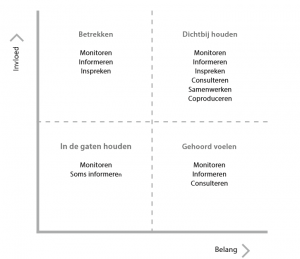Stakeholder management
Monitoring competitors, keeping ambassadors warm or identifying critics. All ingredients for a successful stakeholder policy. And that is becoming increasingly important, partly due to the influence of social media. De Issuemakers advises various clients on their stakeholder management. We map the playing field and weigh attitude, decision-making power and willingness to take action in order to determine the strategy for each stakeholder. Stakeholder management requires constant attention: as soon as the interest of organizations in a particular issue shifts, so does the position of the stakeholders.
Would you like to talk about your organization's stakeholder policy? Please contact us at
What is stakeholder management and why is it important?
There are always several people involved in a company's projects and business activities. These could be, for example, consumers, employees or shareholders. These parties are also called stakeholders. Stakeholders can be seen as parties that the company could not exist without, they are all stakeholders in the organization and also the people who are influenced by the choices of the organization in question.
Stakeholder management provides insight into common and opposing interests. It makes it clear who your supporters and opponents are, who is important to an issue and who is not and how all parties relate to each other. This knowledge helps the organization to choose the right strategy for each stakeholder. Creating support for the project in question and offering a safe environment for all individuals are paramount in stakeholder management.
How do you map stakeholders?
A good stakeholder approach starts with making a longlist. You make an inventory of which people or organizations are involved with the issue. To inventory their intentions, examine the following criteria for each stakeholder: is he positive, negative or neutral towards the issue (attitude), does he have a formal position of power to adjust the policy surrounding an issue (decision-making power), does he have a lot of influence on the way in which people think and write about the issue or the organization (opinion power), he or she has an interest in the issue (interest) and is quickly inclined to take large-scale action (willingness to take action). You then scale each stakeholder based on these five criteria and visualize this in a matrix. The last and perhaps most important question you should ask yourself when dealing with an issue is who or which organization is the issue owner. The person who presents himself as issue owner is expected to contribute to the solution of the issue: by implementing new policy or by requesting widespread attention for the issue and solutions from others.
Model stakeholder strategy
Every stakeholder or interested party needs its own strategy/approach.

This overview helps you determine how best to approach stakeholders and who your supporters and opponents are. After all, proponents require a different approach than opponents or stakeholders who have not yet taken a position.
Involve
At the top left of the overview you will find the stakeholders that it is important to involve in the project in question. This mainly concerns stakeholders who have a lot of influence. Strategies used with these stakeholders can include monitoring, informing and engaging.
Keep close
Next to this you will find stakeholders with a lot of influence and importance. These are very crucial to the potential success of the project. It is the group that often receives the most attention, because you want to keep this group close. As can be seen in the overview, many different strategies are involved: monitoring, informing, speaking, consulting, collaborating and co-producing.
Keep an eye on
This group of stakeholders has the least influence and the least interest in the project. Monitoring will be the main activity for this group. This group may also be informed occasionally, but this will not have to be done on a very frequent basis.
Also see: the rings of influence.
Feeling heard
Finally, there is a group of stakeholders who need to feel heard. Characteristic of this group is a lot of importance and little influence. In terms of strategies, this may include monitoring, informing and consulting.
In addition, the overview shows you who your supporters and opponents are. After all, proponents require a different approach than opponents or stakeholders who have not yet taken a position. Doubting stakeholders in particular can be or become important. They often don't know yet where their preference lies. So there are opportunities there. Inform them in detail about the benefits of your plan, idea or policy. They may be persuaded to support you. But perhaps they are afraid of offending other stakeholders. In that case, think about how you can make them an advocate without putting a strain on their relationship.
You can compare the scores on these five criteria in a graph in various ways. Especially when you compare the influence of a stakeholder on the opinion and decisions surrounding an issue against the interest of that stakeholder in an issue, you get a good idea of how you should involve the various stakeholders in your activities.

